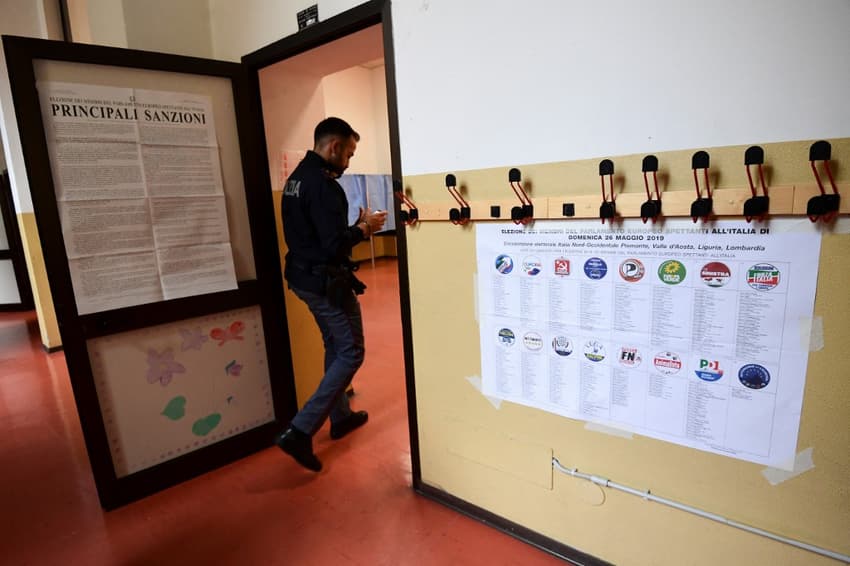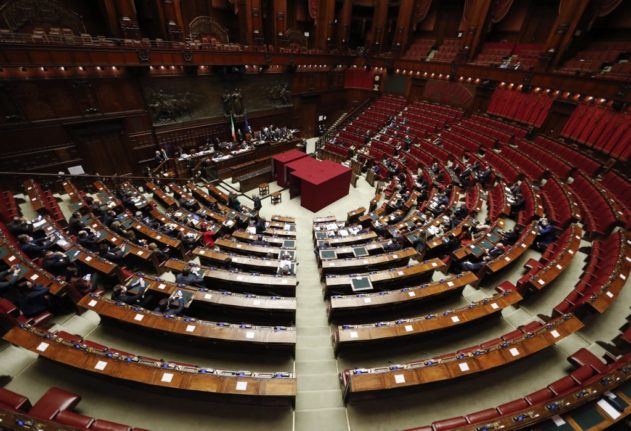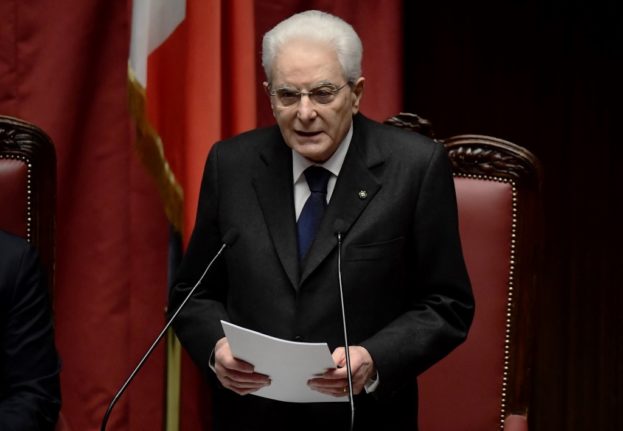Q&A: Your questions answered about how Italy’s elections work

What happens on the day, who can vote, and when will we know the results? Here’s what to expect from Italy’s upcoming general election.
Understanding Italy’s electoral system is no easy feat, especially for those who’ve only recently started following Italian politics.
But it's not too hard to follow or take part once you know the basics.
READ ALSO: Your ultimate guide to Italy’s crucial elections on Sunday
As the September 25th vote nears, here are some of readers' most common questions answered about how it all works.
Who’s eligible to vote?
Only Italian citizens over the age of 18 are eligible to vote in the upcoming elections.
Foreign EU nationals who legally reside in Italy can register to vote in municipal and European parliamentary elections, but national elections are reserved for Italian citizens only.
Remember: you don’t need to be resident in Italy to vote. Italian citizens living abroad can register to vote via post. Find further information on how to vote from abroad here.
READ ALSO: Who can vote in Italy’s elections?

Only Italian citizens aged over 18 will be able to vote in the upcoming elections. Photo by Andreas SOLARO / AFP
Who are the main parties?
Italy has a large number of political parties, and the country is often run by broad coalition governments featuring a mind-boggling number of political names that aren’t always well known beyond Italy’s borders.
But this time around, there are only a few parties you really need to know about.
EXPLAINED: Who’s who in Italy’s general election?
The next government is at least likely to be on the less complicated side, with a coalition of ‘only’ three right-wing parties – Giorgia Meloni’s Brothers of Italy, Matteo Salvini’s League and Forza Italia, led by former premier Silvio Berlusconi – expected to win the vote by a landslide and be given the opportunity to form the next government.
Other parties, including the centre-left Democratic Party led by Enrico Letta and the anti-establishment Five Star Movement, are significantly behind the far-right bloc in the polls.
Find our complete guide to who's who in the Italian elections here.
How do Italian elections work?
They'll work a little differently this time after a constitutional referendum held in 2020.
The electoral system has in fact changed four times in the post-war period, most recently for the 2018 vote.
Under the current system, 61 percent of the seats in both houses are allocated by proportional representation, 37 percent by first-past-the-post -- majority vote -- and two percent by Italians living abroad.
Italians get two votes, one for each house of parliament.
This time, the number of deputies - and therefore seats available - will drop from 630 to 400, while the number of senators will go from 315 to 200.
READ ALSO: An introductory guide to the Italian political system

Following a constitutional referendum held in September 2020, the number of deputies will go from 630 to 400 starting from the upcoming elections. Photo by Yara NARDI / AFP
Once all the lower and upper house seats are allocated through the above system, the head of state starts consultations to choose the new prime minister and their council.
Finally, the head of state assigns the role of prime minister to the political figure who enjoys the support of the winning parties and is thought to be able to receive the parliament’s vote of confidence. The remaining ministers are named immediately after.
The system is confusing both to those at home and abroad, with Pope Francis admitting he did not understand it when asked for his views last week.
How does voting work on the day?
Italian citizens living in Italy must vote in the town in which they are registered to vote, i.e. their municipality of residence or comune, and at the specific polling station assigned to them.
All voters must turn up at their polling station with a valid identity document and their personal voter’s card (tessera elettorale). The card contains the holder’s full name, date of birth, address and polling station, and is stamped every time the holder votes.
Voters who are not able to produce their tessera elettorale at the polling station will not be able to vote.
All voters will be given two ballot papers (pink for the Chamber of Deputies, yellow for the Senate) and will be asked to indicate their choice by leaving a mark next to the chosen party (the papers will use the term ‘lista’ instead of ‘partito’).
All polling stations will open at 7am and close at 11pm on Sunday, September 25th.
When will we know the results?
Polling stations will officially close at 11pm on Sunday, September 25th, with the count to start immediately after.
News media will start releasing the first exit polls as soon as polling stations shut their doors. Though usuallygenerally fairly accurate, polls should not be relied upon blindly – see the 2013 exit poll debacle, for example.
The first official projections based on live results, should come in at around 2am on Monday, September 26th.
Barring a neck and neck contest, an accurate overview of the election’s results should be available by the early hours of Monday morning.
Though the winners are usually known and declared long before then, counting operations, including any potential recount, will likely officially terminate only towards the end of the week.
What kind of political system does Italy have?
Italy is a constitutional republic, with power organised into three different branches: executive, legislative and judicial.
Set up as a safeguard against dictators after World War II, Italy's political system is notoriously volatile, producing no fewer than 67 governments since 1946.
Designed by the founders of Italy's Republic after the downfall of fascist leader Benito Mussolini, it favours coalitions, forcing often antipathetic parties to join forces.
The voting system is a mix of the first-past-the-post system and pure proportional representation.
Executive power is in the hands of the Council of the Ministers, i.e. the cabinet, which is presided over by the President of the Council – more commonly referred to as the prime minister.

The new Italian prime minister will be elected by the head of state, Sergio Mattarella (pictured above), after a series of consultations. Photo by Filippo MONTEFORTE / AFP
Legislative power belongs to the parliament, meaning prime ministers need the support of both houses - both of which have exactly the same powers.
Finally, judicial power belongs to judges, who are responsible for implementing the laws passed by parliament. Italian judges are not elected but are chosen by internal commissions.
When will the new government take office?
The new parliament will convene on October 13th. After that date, President Sergio Mattarella can start consultations with party leaders to discuss the formation of the new government.
The formation of governments in Italy tends to be a very slow process, partly because they're always coalitions between parties, meaning a lot of negotiation is needed.
It’ll take at least 25 days for the new government to take up office. In previous elections it might take significantly longer – in 2018, the first Conte cabinet only assumed its powers 88 days, or almost three months, after the elections.
The result in this election is expected to be more clear cut, meaning things are unlikely to drag out for as long this time.
But nothing is guaranteed: the Italian constitution sets no deadline for the consultations between the president and the parties.
Comments
See Also
Understanding Italy’s electoral system is no easy feat, especially for those who’ve only recently started following Italian politics.
But it's not too hard to follow or take part once you know the basics.
READ ALSO: Your ultimate guide to Italy’s crucial elections on Sunday
As the September 25th vote nears, here are some of readers' most common questions answered about how it all works.
Who’s eligible to vote?
Only Italian citizens over the age of 18 are eligible to vote in the upcoming elections.
Foreign EU nationals who legally reside in Italy can register to vote in municipal and European parliamentary elections, but national elections are reserved for Italian citizens only.
Remember: you don’t need to be resident in Italy to vote. Italian citizens living abroad can register to vote via post. Find further information on how to vote from abroad here.
READ ALSO: Who can vote in Italy’s elections?

Who are the main parties?
Italy has a large number of political parties, and the country is often run by broad coalition governments featuring a mind-boggling number of political names that aren’t always well known beyond Italy’s borders.
But this time around, there are only a few parties you really need to know about.
EXPLAINED: Who’s who in Italy’s general election?
The next government is at least likely to be on the less complicated side, with a coalition of ‘only’ three right-wing parties – Giorgia Meloni’s Brothers of Italy, Matteo Salvini’s League and Forza Italia, led by former premier Silvio Berlusconi – expected to win the vote by a landslide and be given the opportunity to form the next government.
Other parties, including the centre-left Democratic Party led by Enrico Letta and the anti-establishment Five Star Movement, are significantly behind the far-right bloc in the polls.
Find our complete guide to who's who in the Italian elections here.
How do Italian elections work?
They'll work a little differently this time after a constitutional referendum held in 2020.
The electoral system has in fact changed four times in the post-war period, most recently for the 2018 vote.
Under the current system, 61 percent of the seats in both houses are allocated by proportional representation, 37 percent by first-past-the-post -- majority vote -- and two percent by Italians living abroad.
Italians get two votes, one for each house of parliament.
This time, the number of deputies - and therefore seats available - will drop from 630 to 400, while the number of senators will go from 315 to 200.
READ ALSO: An introductory guide to the Italian political system

Once all the lower and upper house seats are allocated through the above system, the head of state starts consultations to choose the new prime minister and their council.
Finally, the head of state assigns the role of prime minister to the political figure who enjoys the support of the winning parties and is thought to be able to receive the parliament’s vote of confidence. The remaining ministers are named immediately after.
The system is confusing both to those at home and abroad, with Pope Francis admitting he did not understand it when asked for his views last week.
How does voting work on the day?
Italian citizens living in Italy must vote in the town in which they are registered to vote, i.e. their municipality of residence or comune, and at the specific polling station assigned to them.
All voters must turn up at their polling station with a valid identity document and their personal voter’s card (tessera elettorale). The card contains the holder’s full name, date of birth, address and polling station, and is stamped every time the holder votes.
Voters who are not able to produce their tessera elettorale at the polling station will not be able to vote.
All voters will be given two ballot papers (pink for the Chamber of Deputies, yellow for the Senate) and will be asked to indicate their choice by leaving a mark next to the chosen party (the papers will use the term ‘lista’ instead of ‘partito’).
All polling stations will open at 7am and close at 11pm on Sunday, September 25th.
When will we know the results?
Polling stations will officially close at 11pm on Sunday, September 25th, with the count to start immediately after.
News media will start releasing the first exit polls as soon as polling stations shut their doors. Though usuallygenerally fairly accurate, polls should not be relied upon blindly – see the 2013 exit poll debacle, for example.
The first official projections based on live results, should come in at around 2am on Monday, September 26th.
Barring a neck and neck contest, an accurate overview of the election’s results should be available by the early hours of Monday morning.
Though the winners are usually known and declared long before then, counting operations, including any potential recount, will likely officially terminate only towards the end of the week.
What kind of political system does Italy have?
Italy is a constitutional republic, with power organised into three different branches: executive, legislative and judicial.
Set up as a safeguard against dictators after World War II, Italy's political system is notoriously volatile, producing no fewer than 67 governments since 1946.
Designed by the founders of Italy's Republic after the downfall of fascist leader Benito Mussolini, it favours coalitions, forcing often antipathetic parties to join forces.
The voting system is a mix of the first-past-the-post system and pure proportional representation.
Executive power is in the hands of the Council of the Ministers, i.e. the cabinet, which is presided over by the President of the Council – more commonly referred to as the prime minister.

Legislative power belongs to the parliament, meaning prime ministers need the support of both houses - both of which have exactly the same powers.
Finally, judicial power belongs to judges, who are responsible for implementing the laws passed by parliament. Italian judges are not elected but are chosen by internal commissions.
When will the new government take office?
The new parliament will convene on October 13th. After that date, President Sergio Mattarella can start consultations with party leaders to discuss the formation of the new government.
The formation of governments in Italy tends to be a very slow process, partly because they're always coalitions between parties, meaning a lot of negotiation is needed.
It’ll take at least 25 days for the new government to take up office. In previous elections it might take significantly longer – in 2018, the first Conte cabinet only assumed its powers 88 days, or almost three months, after the elections.
The result in this election is expected to be more clear cut, meaning things are unlikely to drag out for as long this time.
But nothing is guaranteed: the Italian constitution sets no deadline for the consultations between the president and the parties.
Join the conversation in our comments section below. Share your own views and experience and if you have a question or suggestion for our journalists then email us at [email protected].
Please keep comments civil, constructive and on topic – and make sure to read our terms of use before getting involved.
Please log in here to leave a comment.